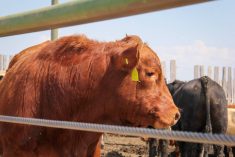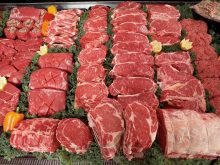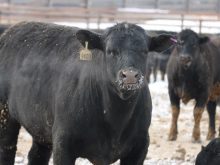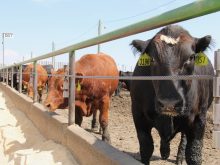The beef and cattle markets continue to recover from the effects of the COVID pandemic.
During the first quarter of 2020, beef demand was adjusting to higher unemployment levels as coronavirus spread throughout the U.S. and Canada. The problem was exacerbated when outbreaks of the virus among workers forced processing plants in Canada and the U.S. to either shut down or operate at sharply lower capacity.
Fed cattle became backed up in the feedlot pipeline while a surge in retail demand caused the wholesale beef values to reach historical highs. The stimulus and aid packages supported overall beef demand although restaurant spending was down sharply throughout 2020. Restaurant traffic suffered due to capacity constraints or closures in both Canada and the U.S.
Read Also

Harvest wraps up and fall work begins
At the Eppich famly ranch in western Saskatchewan, the fall harvest was successful with few breakdowns, cows and calves have been sorted and a new tractor has arrived
In the latter half of 2020, the number of cattle processed in Canada and the U.S. actually exceeded expectations. The U.S. has cleaned up the backlog of market-ready supplies. However, there are still cattle on the Canadian fed cattle set-aside program, although the numbers have come down drastically over the past couple of months.
During the height of the COVID pandemic from March through May of 2020, the U.S. cow-calf producer backed away from selling feeders while the Canadian rancher sold regular volumes, in line with their seasonal tendency. Producers are now asking how beef demand will materialize as the vaccination rollout materializes. Secondly, the market is always vulnerable to policy changes under a new U.S. government administration.
Inelastic demand
It’s important to note that beef demand is inelastic. A small change in supply has a large effect on the price — for example, the old saying that “I’ll pay for one steak but you have to pay me to eat two.” Another factor to consider is that a one per cent increase in consumer spending equates to a one per cent increase in beef demanded. The price of substitutes has very little effect on beef demand because half of the carcass is consumed by households with average to above-average incomes. We all know that this recession affected the lower-income bracket more severely than middle- or upper-income earners.
As of Feb.1, 2021, media reports suggested that the U.S. and Canada were at the height of the COVID pandemic. It’s important to note that the situation is not deteriorating but will improve. The vaccination process is a monumental task. Early projections suggest that the U.S. should be vaccinating one million people per day during April. Government indications indicate Canada will be vaccinating one million people per week during the second quarter of 2021. This is positive news for the beef complex. The wholesale beef market has been quite volatile over the past year because restaurants couldn’t project their demand. The uncertainty is decreasing and we’ll likely see the restaurant industry return to longer-term contracts over the next year.
During January, U.S. restaurant traffic was running 60 per cent below year-ago levels while in Canada, restaurant traffic was down 80 per cent from last year. Once we move into the second quarter, we’ll likely see U.S. restaurant traffic down about 30 per cent from the five-year average and Canadian restaurant traffic will be down approximately 50 per cent from the longer-term average.
Last fall, U.S. consumer spending at “restaurants and other eating out places” was down 13 per ent from 2019 but spending at grocery stores was up eight to 12 per cent over year-ago levels. By the time we move into late spring, restaurant and retail spending will resume some type of normalcy. During January 2021, there were about 10 million Americans unemployed due to the COVID pandemic. Approximately two-thirds of these workers should be back at work by the summer. Most Canadian jobs lost to the pandemic will also be back on stream by the summer.
Production could be record
The number of cattle processed at Canadian and U.S. packing plants exceeded expectations from July through December 2020. This resulted in historically high beef production during the final quarter of 2020 — it might even be a record for North America.
During the spring of 2020, U.S. ranchers held back on sales while the Canadian cow-calf producer and backgrounder sold cattle in line with past years. The backlog of supplies at U.S. feedlots was largely cleaned up by the end of December. However, fed cattle market-ready supplies were sharply above year-ago levels. The fed cattle set aside program was still being used during the first two weeks of January.
Without going into detail, Alberta and Saskatchewan placements were down sharply from year-ago levels from September through December of 2020. Both Canada and the U.S. will have cleaned up the backlog of market-ready supplies by mid-April. Given the placements by weight category in the past cattle-on-feed reports, it appears that both Canada and the U.S. will have a relatively tight fed-cattle supply situation during the summer. This a very strong counter-seasonal price trend that’s developing.
Canadian cattle producers always hold their breath when a new administration takes the reins in the U.S. President Biden’s “Buy American” policy appears to be only for federal government contracts but will this expand into other areas of the economy? We all remember Country of Origin Labelling policy (COOL). That was under Agriculture Secretary Tom Vilsack, who has his old job back.
The new administration is lasering in on climate change policies and it is also concerned about workers in large-scale plants owned by multinationals, and enforcement of antitrust measures. The changes in energy policy could cause corn and feed grain prices to increase. At this time, it is very difficult to forecast the implications because the scope of policy changes covers a wide range of supply and demand issues.
It appears we are currently at the height of the COVID pandemic. The vaccination process is expected to be widespread by the summer on both sides of the border. The lifting of restaurant and gathering constraints will cause beef demand to surge in the second quarter. The backlog of market-ready supplies will be cleaned up later in spring and beef production will experience a sharp year-over-year decline during the summer months. This should result in higher fed-cattle prices. It’s difficult to forecast the effects of policy changes from the Biden Administration. The policy changes regarding energy are expected to increase corn and feed grain prices longer term. Look for more transparency on U.S. prices of feeder cattle and fed cattle.
















